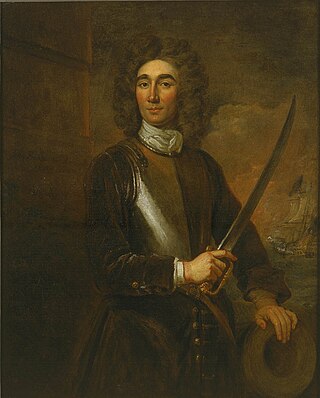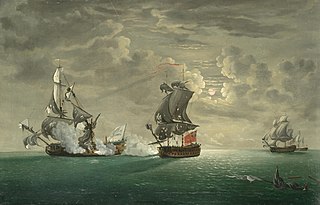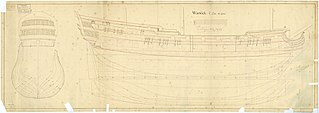
Willem van de Velde the Younger was a Dutch marine painter, the son of Willem van de Velde the Elder, who also specialised in maritime art. His brother, Adriaen van de Velde, was a landscape painter.

Vice-Admiral John Benbow was an English Royal Navy officer. He joined the Navy in 1678, seeing action against Barbary pirates before leaving to join the Merchant Navy in which Benbow served until the 1688 Glorious Revolution, whereupon he returned to the Royal Navy and was commissioned.

Willem van de Velde the Elder was a Dutch Golden Age seascape painter, who produced many precise drawings of ships and ink paintings of fleets, but later learned to use oil paints like his son.

Francis Swaine (1725–1782) was a British marine painter.

On 18–19 December 1669, a battle took place in the waters near Cádiz between the English fourth-rate frigate Mary Rose under the command of Rear-Admiral John Kempthorne, escorting several merchantmen, and a group of seven pirate ships operating out of Algiers. The incident was recorded and drawn by the engraver Wenceslaus Hollar, with an engraving appearing in John Ogilby's Africa.

Peter Monamy was an English marine painter who lived between 1681 and 1749.

HMS Royal James was a 102-gun first rate ship of the line of the Royal Navy, built by Anthony Deane at Portsmouth Dockyard at a cost of £24,000, and launched on 31 March 1671.

HMS Captain was a 70-gun third rate built at Woolwich Dockyard in 1677/78. After sitting in Ordinary for ten years she was in active commission for the War of the English Succession fighting at Beachy Head and Barfleur. She was in Ordinary until 1706 when she was rebuilt. She was in active commission for the last half of the War of Spanish Succession but fought in no major engagements. She was at the Battle of Passero I 1718. She was rebuilt in 1720/22. She made two forays in to the Baltic though the bulk of her late career was spent as guardship at Portsmouth. She was hulked in 1740 and finally broken in 1762.

HMS Expedition was a 70-gun third-rate ship of the line built at Portsmouth Dockyard in 1677/79. She was in active commission during the War of the English Succession participating in the battles of Beachy Head and Barfleur. She was rebuilt in 1699. Again, for the War of Spanish Succession she was in commission for the operation at Cadiz then returned to England where she sat for two years. She was in the Mediterranean for the Battle of Marbella in 1705. She then went to the West Indies and fought in Wager's action off Cartagena in 1708. She was rebuilt in 1709-14 to the 1706 Establishment. She spent her time split between the Baltic and as guard ship at Portsmouth before being broken at Portsmouth in 1736. She was rebuilt in 1736/40 at Deptford Dockyard.
HMS Pendennis was a 70-gun third rate ship of the line of the Kingdom of England built at Chatham in 1677/79. She was in the War of English Succession. She was in the Battle of Bantry Bay. She was wrecked on the Kentish Knock in October 1689.
Sir John Kempthorne was an officer in the English Royal Navy during the Second and Third Anglo-Dutch Wars, who eventually rose to the rank of Vice-Admiral.

HMS Warwick was a 60-gun fourth-rate ship of the line of the Royal Navy, built to the 1719 Establishment at Plymouth by Peirson Lock. The keel was laid down on 1 April 1730, and the ship was launched on 25 October 1733, and completed on 24 August 1734.
HMS Boyne was a 70-gun third rate ship of the line of the Royal Navy, built at Plymouth Dockyard to the draught specified in the 1745 Establishment as amended in 1754, and launched on 31 May 1766. She was first commissioned for the Falkland Crisis of 1770 after which, in 1774, she sailed for North America. From March 1776, she served in the English Channel then, in May 1778, she was sent to the West Indies where she took part in the battles of St Lucia, Grenada and Martinique. In November 1780, Boyne returned home, where she was fitted for ordinary at Plymouth. In May 1783, she was broken up.

Isaac Sailmaker was an etcher and marine painter of the Baroque period, who had a long career in England. He was referred to in contemporary books and journals as "the father of British sea painting", but was eclipsed by his contemporaries, the Dutch marine painters Willem van de Velde the Elder and his son Willem van de Velde the Younger, who for a period dominated the London market. Sailmaker was commissioned by the English Lord Protector, Oliver Cromwell, to paint the English fleet at Fort-Mardyck.
Sir Francis Wheler was an officer of the Royal Navy who served during the Nine Years' War.
Ralph Wrenn was an English naval commodore.
The Expedition was a 30-gun "pinnace" in the service of the English Navy Royal. After an initial participation in a punitive attack on Morocco, she spent the majority of her career in Home Waters. During the English Civil War she was employed in the Parliamentary Naval Force. In 1551 she was assigned to the Commonwealth Navy. During the First Dutch War she took part in the Battle of Portland, the Battle of the Gabbard and the Battle of Scheveningen in 1553. During the Second Dutch War she participated in the Battle of Lowestoft in 1665 and the Four Days' Battle and the St James' Day Battle (Orfordness) in 1666. She was re-classed as a 32-gun ship in 1666, but then again re-rated and converted to a fireship in June 1667, and then sold in October 1667.
Providence was a 30-gun "pinnace" in the service of the English Navy Royal. After an initial participation in a punitive attack on Morocco, she spent the majority of her career in Home Waters. During the English Civil War she was employed in the Parliamentary Naval Force. In 1551 she was assigned to the Commonwealth Navy. During the First Dutch War she took part in the Battle of Portland, the Battle of the Gabbard and the Battle of Scheveningen in 1553. During the Second Dutch War she participated in the Battle of Lowestoft in 1665 and the Four Days' Battle and the St James' Day Battle (Orfordness) in 1666. She was re-classed as a 32-gun ship in 1666, but then again re-rated and converted to a fireship in June 1667, but was wrecked at Tangier on 31 October 1667.
The English ship Martin was a 14-gun sixth rate vessel built under the 1651 Programme at Portsmouth Dockyard for the Commonwealth of England in 1651/52. Her service in the Commonwealth Navy was very active. She participated in the Battles of Dover, Portland and the Gabbard. She was with Robert Blake at Porto Farina. She was the main vessel at the Capture of Jamaica in 1655. With the Restoration she became HMS Martin. During the Second Anglo-Dutch War she was in the initial battle of Lowestoft then the Battle of Vagen. She was sold in February 1667.

On 28 December 1669, as the Mary Rose, a third-rate, carrying forty-eight guns, with a crew of 230 men, commanded by Captain John Kempthorn, was convoying a fleet of merchant ships through the Straits of Gibraltar, seven large Algerine corsairs, full of men, stood towards her. Captain Kempthorn ordered the convoy to make sail, while he, single-handed, advanced to engage the foe. The fighting continued into the following day, as the Algerines attacked the Mary Rose with much fury, and boarded her; but were beaten off with considerable loss. The convoy reached Cádiz in safety.















